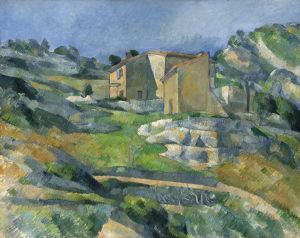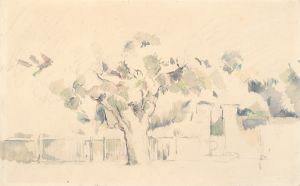
La Route tournante en sous-bois
A hand-painted replica of Paul Cézanne’s masterpiece La Route tournante en sous-bois, meticulously crafted by professional artists to capture the true essence of the original. Each piece is created with museum-quality canvas and rare mineral pigments, carefully painted by experienced artists with delicate brushstrokes and rich, layered colors to perfectly recreate the texture of the original artwork. Unlike machine-printed reproductions, this hand-painted version brings the painting to life, infused with the artist’s emotions and skill in every stroke. Whether for personal collection or home decoration, it instantly elevates the artistic atmosphere of any space.
Paul Cézanne's painting "La Route tournante en sous-bois," also known as "The Turning Road," is a notable work that exemplifies the artist's innovative approach to landscape painting. Created around 1902-1906, this painting is part of Cézanne's later period, during which he focused on capturing the essence of nature through a unique blend of form and color.
Cézanne, a French Post-Impressionist painter, is often credited with laying the groundwork for the transition from 19th-century artistic concepts to the radically different world of 20th-century art. His work is characterized by a departure from the Impressionist emphasis on capturing fleeting effects of light and atmosphere. Instead, Cézanne sought to reveal the underlying structure of the natural world through careful composition and a methodical application of color.
"La Route tournante en sous-bois" is a quintessential example of Cézanne's mature style. The painting depicts a winding road through a wooded area, a subject that allowed Cézanne to explore the interplay of light and shadow as well as the geometric forms found in nature. The composition is marked by a dynamic sense of movement, as the road curves and disappears into the dense foliage, inviting the viewer to imagine what lies beyond the visible scene.
Cézanne's technique in this painting involves the use of short, hatched brushstrokes, which build up the surface of the canvas and create a sense of depth and texture. This approach allows the viewer to perceive the solidity and volume of the trees and the road, while also conveying the dappled light filtering through the leaves. The palette is dominated by earthy tones of green, brown, and ochre, punctuated by touches of blue and white that suggest the sky and sunlight.
The painting reflects Cézanne's interest in the Provençal landscape, a region in southern France that he frequently depicted in his work. The rugged terrain and vibrant colors of Provence provided Cézanne with endless inspiration, and he often returned to similar motifs, exploring them from different angles and under varying conditions.
"La Route tournante en sous-bois" is housed in the Musée d'Orsay in Paris, which holds an extensive collection of Impressionist and Post-Impressionist masterpieces. The painting is considered an important example of Cézanne's contribution to the development of modern art, influencing subsequent generations of artists, including the Cubists and Fauves, who admired his ability to break down natural forms into their geometric components.
Cézanne's work, including "La Route tournante en sous-bois," continues to be studied and celebrated for its pioneering approach to form and color. His ability to convey the essence of the natural world through a synthesis of observation and abstraction has cemented his reputation as a pivotal figure in the history of art.


















